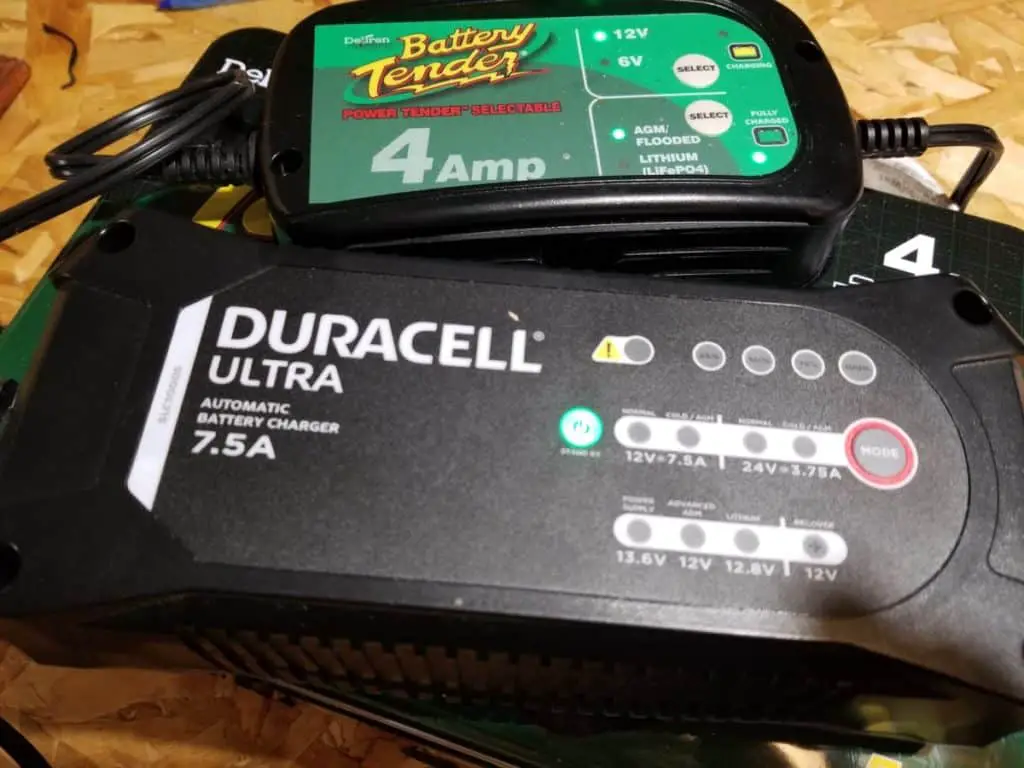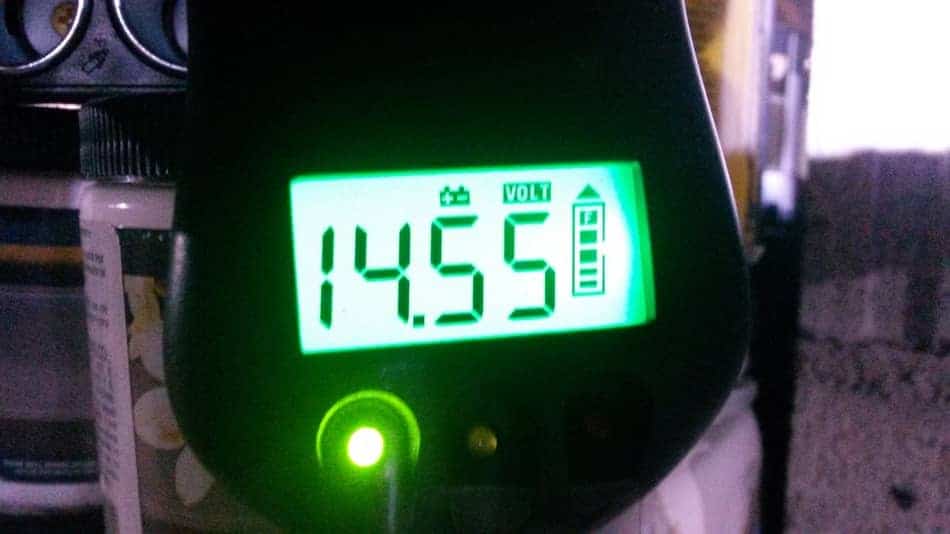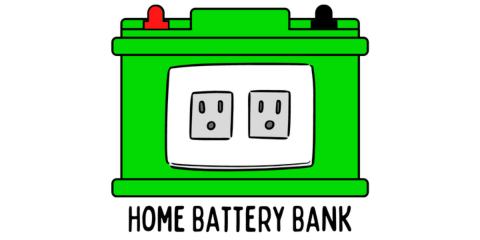Batteries will have the longest lifespan if they are in a fully charged state. Knowing this, it bears the question: is it okay to leave a battery maintainer connected to a battery all the time?
It is safe to leave a battery maintainer connected to your battery all the time. Maintainers will only emit a charge when the battery’s voltage drops below 100% state of charge. A monthly visual inspection should still take place for safety.
When I first set up my battery bank 6 years ago, this was one of my first questions and I’m happy to share what I’ve learned.
Why it’s Perfectly Fine to Leave Your Battery Maintainer Connected to Your Battery
The goal when maintaining a battery for the long-term is to maximize its lifespan by keeping the state of charge at 100%.
If you allow it to drop below 100%, the chemical reaction inside the electrolyte is actually starting to reverse and the plates inside of the battery gradually begin to build a layer of sulfate (sulfation).
The longer you leave your battery under the 100% state of charge, the more the sulfate on the lead plates will crystallize. Once crystallized, it will hinder the conductivity within the battery and increase internal resistance.
This will lead to decreased power and your battery will have a higher chance of overheating during the charging process or during discharge.
The way to keep your battery at 100% charge is with a battery maintainer.
The cool thing about battery maintainers is that when you hook them up to your battery, it’s essentially a mini-computer with a diagnostics system that perpetually monitors the state of charge of your battery and keeps it precisely at 100% without over-charging.

It is safe to leave a battery maintainer connected to your battery after you have established the following:
- Water Levels are Good (if it’s a flooded battery)
- Specific Gravity is Good (if it’s a flooded battery)
- You’ve tested the maintainer first while monitoring it for any abnormalities
Just remember that battery maintainers (or float chargers) are not the same as trickle chargers! (though sometimes people use the terms interchangeably)
Trickle chargers are more of an antiquated style of charger, and they lack the microprocessor which perpetually monitors the state of charge of your battery.
A true trickle charger will actually keep pumping current into your battery (even though it’s just a small amount) even after the battery has reached 100% charge.
Unable to process this residual electrical current into chemical stored energy, the battery will release the energy through heat and evaporation of the water within the electrolyte.
When you lose enough water your lead plates are exposed and when they are exposed to oxygen irreparable damage is done to them and your battery will lose power and time off of its lifespan.
How to Tell if My Charger is a Battery Maintainer?
When looking for a battery maintainer you want to make sure the unit that you go with has either a float/maintenance mode and that it is microprocessor controlled.
I’ve tested out many chargers over the years and I’ve come to rely completely upon this model seen on Amazon. These chargers have always gently charged my batteries without overcharging and without making the battery sound like it was boiling. It is a true “set it and forget it” experience and I’ve been more than satisfied.
They come in 3, 4, and 5 amp models which would all work great for car/truck/marine and golf cart batteries. I’d personally go with the 5-amp model because it’s the faster of the 3 but not high enough that it poses a danger to your battery through overcharging.
For a smaller battery, like for a lawnmower, jet ski, motorcycle, and ATV, they also make a smaller 800mA maintainer as well (for 12-volt batteries).
If you have a battery other than 12-volts (6, 8, 24), they do make other maintainers that would work for you as well, you’ll just want to verify the voltage before you purchase.
Best Way to Hook Up Your Battery Maintainer for Long-Term Use
With the maintainer unplugged, I like to hook up the positive (red) cord to the battery terminal post using and eyelet connection and an appropriately sized nut for your particular battery. Generally, they are 3/8″, 5/16″ or a combination of the two.
Make sure your nut it screwed on tight! If it is loose, this will cause heat to build up as the electricity is trying to make a solid connection. You do not want excessive heat above your battery.
I use the eyelet connections for long-term use and the alligator clamps for short-term use. Either way is typically fine, but an eyelet connection with a tight nut will give you the best connection.
I also always use an electronic voltmeter with a DC connection to the battery studs so that I can always monitor my battery and quickly notice any abnormalities.

This is the 12-volt adapter that I use to hook up to the battery and this is the voltmeter. I believe these are a no-brainer when it comes to charging. They are cheap and you can quickly glance at it to make sure it is in a safe range without having to find an actual multi-meter to test your battery.
Quarterly Maintenance is Still Recommended (monthly is even better!)
Even though a battery maintainer is a “set it and forget it” type of thing, it’s still recommended to check on your batteries at least quarterly throughout the year.
If you have a sealed battery, there’s not much you’re going to be able to do as these batteries are mostly maintenance-free. Any water lost due to the charging process is recycled back into the solution as long as the overcharging was not excessive.
Just look for any corrosion and carry on as normal as long as the voltage reading still looks like it’s in the appropriate range on the electronic voltmeter.
If you have a flooded battery, remove the caps and check the water levels. On my batteries, I normally have to add about 10 ml of water per cell every 3 months or so. Use only distilled water, and I recommend using a plastic syringe for children’s medication to carefully inject the water instead of attempting to pour it from a jug.

It’s also a good idea to use a hydrometer to check the specific gravity in each of the cells. This is how you will be able to determine if you’ve got a cell that’s going bad in your battery. It only takes one weak or bad cell to ruin the rest of your battery through overcharging.
The overcharging happens when the charger/maintainer will read the total voltage of your battery (which should be around 12.6-12.7 when fully charged for a 12-volt battery). Each cell (there are 6 in a 12-volt battery) should measure at 2.1 volts when fully charged.
If a cell has gone bad or is compromised, the charger might read the entire battery at 10.5, for example, and do its best to bring the total charge up to 12.6-12.7 — but it would be raising the 5 functioning cells to that level and not the 6th one which is now bad (likely due to sulfation).
In order to get to 12.6-12.7, each cell would have to be 2.52+ volts… and they simply cannot support this. The water will quickly evaporate from the electrolyte and leave you with exposed lead plates which will start to sulfate as well.
If you have a bad cell it is time to look into getting a new battery.
When You Should NOT Leave Your Battery Maintainer Hooked Up to Your Battery
Like we just mentioned above, a damaged cell is a primary reason why you should not leave a battery maintainer (or any charger, for that matter) hooked up to your battery for the long-term.
This will only serve to overcharge your battery which will ruin the other cells through sulfation after the lead plates are exposed to air.
Eventually, if you left the charger on long enough and all of the water evaporated out, you would be at high risk for a fire or explosion with the charger still connected to a mostly dry battery.
A reputable battery maintainer or smart charger should recognize there is a problem and turn off to prevent anything from happening, but why take the chance?
Always Supervise Your Battery Maintainer for a While Before Leaving it on Unattended
Of course, before you leave your battery maintainer on your battery for months on end without checking on it, make sure to use it first to charge your battery and monitor it as you go so that you get a feel for how the charger works and to detect any abnormalities or problems.
After you’ve felt comfortable with it, go ahead and give it a shot. Again, I recommend this battery maintainer from Amazon for a safe and user-friendly experience.

